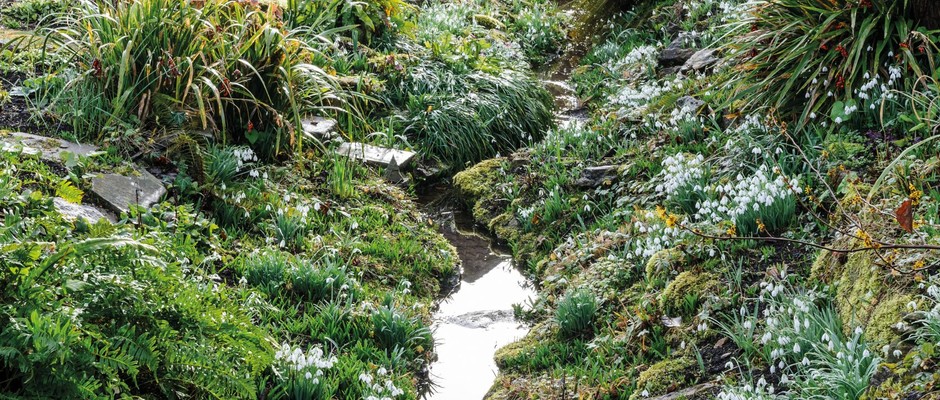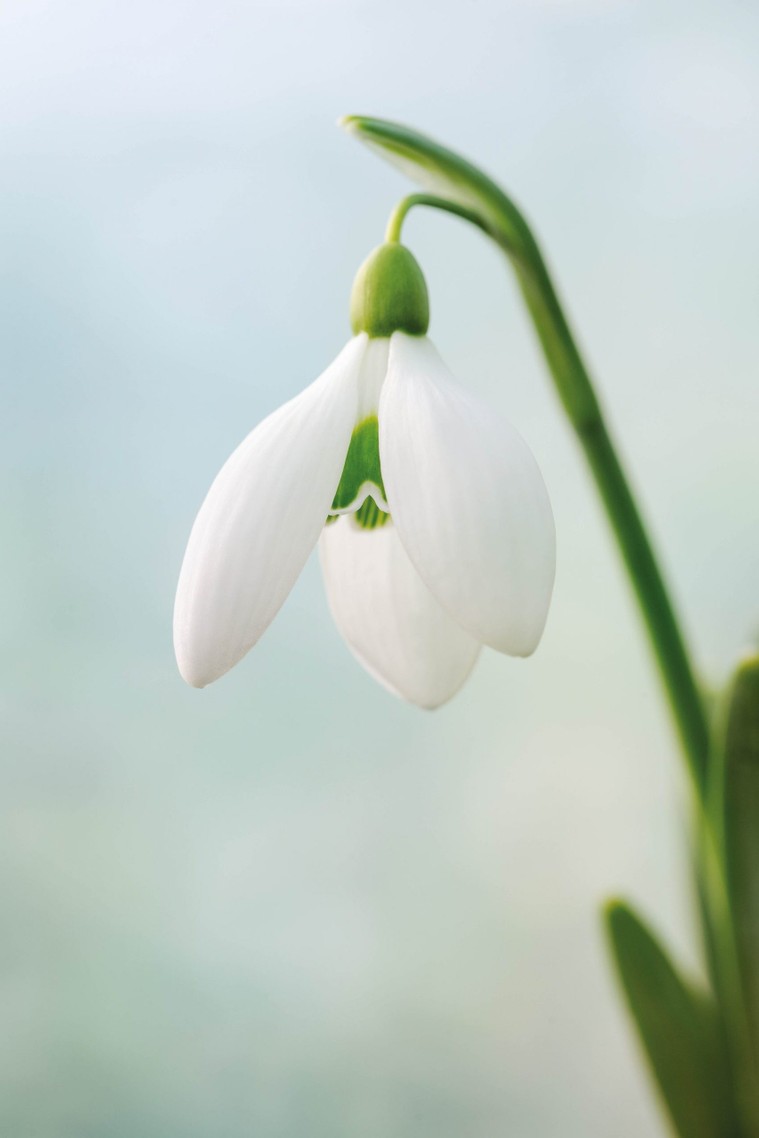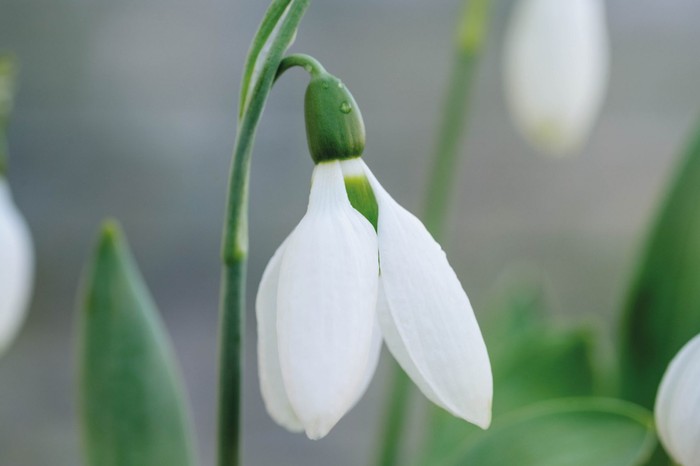
Margery Fish's remarkable snowdrops at East Lambrook Manor
Margery Fish is best known for her books on creating her garden at East Lambrook Manor but, as designer Isabel Bannerman discovers, she was also an galanthophile who filled her garden with snowdrops. Photographs Jason Ingram.
When we moved back to Somerset recently, not ten miles from East Lambrook Manor, a return to this legendary garden of the prolific garden writer Margery Fish was high on the to-do list. The eight books she wrote between 1956 and her death in 1969 were formative to our parents’ generation. She was the queen of the middle-sized cottage garden – ‘as modest and unpretentious as the house’.

Margery comes across as the epitome of modest and unpretentious. Her ‘look’ is very familiar and currently very unfashionable; crazy paving with alpine planting; silver and variegated shrubs along with signature blue conifers; loose herbaceous perennials. An absolute joy in later winter are the naturalised bulbs. The garden, and hence her writing, was about manageable ambitions: Margery gardened her own garden, and for that reason her advice is always reasonable, practical and still valid to those of us gardening away today. Our return was infused with some considerable nostalgia: my husband Julian and I had originally visited when we were first together in 1983.
Margery Fish's snowdrops at East Lambrook Manor (1 to 10)
Showing item 1 of 10





















Margery’s real heart shines out in her winter and spring world; her green hellebores; her ferns galore; her liberal use of her strain of Euphorbia characias subsp. wulfenii ‘Lambrook Gold,’ which has long been a top plant of mine – silver-edges may not find favour with me but everyone likes a bit of gold. Snowdrops followed by scillas swamp the Ditch, which was her miracle invention, a rock garden without being a construct, a sunken garden that splits the space in two. She loved wintersweet and winter-flowering Algerian irises, cyclamen, violets and the unsurpassable spring luminosity of primroses. Bulbs and naturalising she really understood. Tulipa sprengeri spring everywhere – an ambition to take home and nurture.

Mike Werkmeister and his wife Gail are the current owners and curators of this Grade I-listed garden. They came, like Margery and Walter Fish, after a busy life in London. But they have never worked harder, keeping the flame burning along with Mark Stainer, their inherited head gardener, who has been at East Lambrook for more than 40 years. Mike’s idea to host a Festival of Snowdrops has put considerable life into their February opening. Galanthophilia has caught fire among this nation of gardeners. Who would have thought it?
Well, Margery Fish of course. Margery liked green flowers, especially the green-marked snowdrops. She championed the doubles, such as Galanthus ‘Ophelia’, because they open even in dim light. She loved Galanthus ‘Magnet’ with its wiry pedicels, the pearls dancing ‘en tremblant’ like jewellery. She was not a fan of the rare and pricey yellow ones, although she kept Galanthus nivalis f. pleniflorus ‘Lady Elphinstone’ in a trough on the sunny side of the Malthouse. Seedlings abound in the garden: Galanthus ‘Dodo Norton’ is a seedling identified in the Ditch, a remarkable snowdrop: thick, short, and with an opaqueness of white akin to sun-block.
‘One of the most delightful things about gardening is the freemasonry it gives with other gardeners,’ wrote Margery, a generous thought and a truth that abides. The freemasonry is alive and well and, it seems, her garden will be kept going, the snowdrops ever-increasing and ever more enjoyed.
Margery Fish's snowdrops at East Lambrook Manor (11 to 20)
Showing item 1 of 10





















Our pick of the snowdrops at East Lambrook Manor
Galanthus elwesii 'Godfrey Owen'

Very distinctive and unusual snowdrop, with six outer and six inner petals. It’s early flowering and bulks up well. It was found in the Shropshire garden of the well-known gardener Margaret Owen, in around 1996 and named by her after her late husband. 15cm. AGM. RHS H5.
Galanthus 'Ophelia'

It was a gift of this green-centred double snowdrop, bred by Heyrick Greatorex in the 1940s, that first sparked Margery’s interest in Galanthus. 15cm. RHS H5.
Galanthus elwesii

Discovered in western Turkey, in 1874, by the plant collector Henry John Elwes, this tall and handsome species can also be found throughout the Balkans. The joy of Elwes’s snowdrop is that it multiplies exponentially with broad, glaucous leaves and nodding, solitary white flowers in late winter. 20cm. AGM. RHS H5.
More like this
Galanthus plicatus ‘Phil Cornish’

Stunning selection from the Gloucestershire garden of Phil Cornish. Very dark green inners and pale green outers, it appears to be related to Galanthus plicatus ‘Trym’, with similar distinctive outer petals that form a curved, pixie hat. 12cm.
Galanthus ‘Ivy Cottage Corporal’

Dark-green corporal’s stripes near the ovary gave rise to the plant’s name. It is a robust plant with long, elegant flowers. 30cm. RHS H5.
Galanthus nivalis ‘Margery Fish’

An East Lambrook seedling found in the Ditch in 1987 with narrow delicate-looking petals infused with green. Can be slow to increase. 15cm.
Useful information: Address East Lambrook Manor Gardens, East Lambrook, South Petherton, Somerset TA13 5HH. Tel 01460 240328. Web eastlambrook.com Open February to October, see website for details. Admission £6. The East Lambrook Festival of Snowdrops takes place throughout February, see website for details. Pre-booking available.

Niwaki bundle worth £57 when you subscribe
Subscribe to Gardens Illustrated magazine and claim your Niwaki bundle worth £57
*UK only

Container Gardening Special Edition
The Gardens Illustrated Guide to Container Gardening.
In this special edition, discover colourful flower combinations and seasonal planting schemes for pots designed by leading plantspeople, and essential know-how for container gardening success. Just £9.99 inc UK p&pBy entering your details, you are agreeing to our terms and conditions and privacy policy. You can unsubscribe at any time.

Gardens of the Globe
From botanical wonders in Australia to tranquil havens closer to home in Ireland, let this guide help you to discover some of the most glorious gardens around the world
By entering your details, you are agreeing to our terms and conditions and privacy policy. You can unsubscribe at any time.




